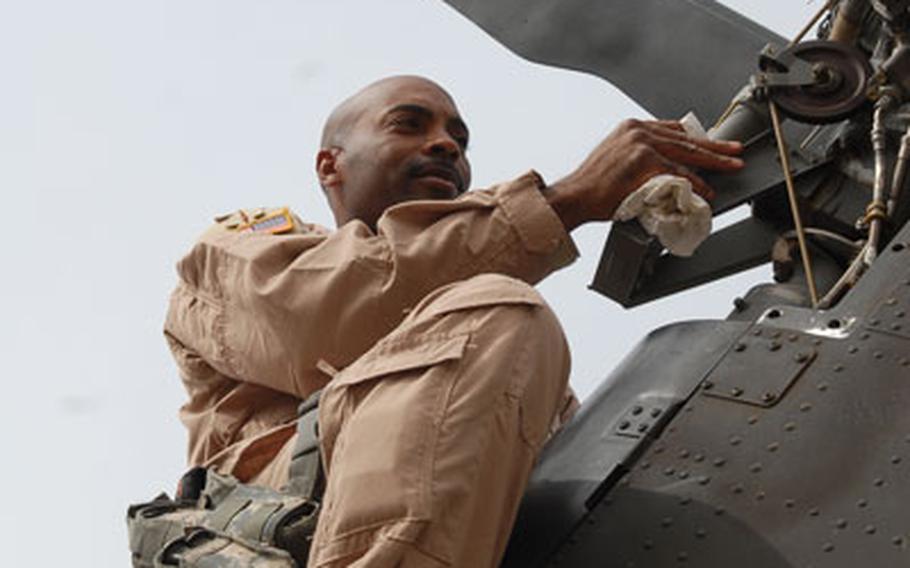
First Sgt. Marvin Meeks, 41, of El Dorado, Ark., checks the tail on a Black Hawk on Sunday after dropping off Gen. David Petraeus, senior American commander in Iraq, at Baghdad International Airport. Crews that fly VIPs like Petraeus keep the helicopters ready to go at a moment's notice. (James Warden / Stars and Stripes)
BAGHDAD — The rotors are turning, but the Black Hawks aren’t going anywhere for the moment.
Crews in the two helicopters wait patiently, one minute, then another. A door gunner drums his fingers on a windowsill, but that’s the only sign of anxiousness. Waiting is just another part of the job for these two crews.
After all, they can’t just leave behind the senior American commander in Iraq.
This platoon-sized group with Company A, 5th Battalion, 158th Aviation Regiment, based out of Wiesbaden and Katterbach, Germany, has one mission in Iraq: Move VIPs. In Army parlance they’re called a Command Aviation Company, or “CAC.” The group primarily serves Gen. David Petraeus and Multi-National Corps — Iraq commander Lt. Gen. Lloyd J. Austin III.
Celebrity doesn’t much impress these fliers, although some of them are still a bit miffed that they didn’t get to move around the NFL cheerleaders who visited Iraq. Most of them had the same job back in Germany. They’ve flown former president George H.W. Bush, among other big names.
“Flying an E-3 is the same as flying a four-star. You kill one it’s the same as killing another,” said Sgt. James Tully, a 24-year-old crew chief from Phoenix.
“Flying’s flying in my book,” added Spc. Jimmy Blundell, a 28-year-old crew chief from Dallas.
None of the crews interact much with the VIPs. Pilots are busy flying. Conversation ranges along the lines of how the weather’s been, said Chief Warrant Officer 2 Caleb Weand.
Weand is one of Petraeus’ primary pilots, meaning his sole job in Iraq is to fly the general around. Other pilots rotate into the CAC periodically but later return to their usual duties.
Yet each high-profile passenger brings his or her own personality.
Petraeus, for example, likes to detour over certain Iraqi neighborhoods to get a feel for how the area is improving. He also likes to fly fast and frequently.
“We go as fast as the birds can go for General Petraeus,” said Capt. Susan Woody, the officer in charge of the unit. “He’s real quick to speak up … Literally every second of their day counts.”
This day, the crews have been waiting about 10 minutes when a pair of black SUVs pulls onto a driveway that parallels the helipad near where Petraeus works at Camp Victory. The general gets out and strides to the helicopter without ceremony. Moments later, the birds are in the air heading toward Baghdad International Airport.
The helicopters are nearly identical to the aircraft that cart the lowliest private over the battlefield. The missions are also often usually straightforward. It’s the passengers who create the pressure in this job.
There’s also the weather. Routine shuttles around Iraq stop as soon as the weather is the least bit dangerous. But commanding generals such as Petraeus and Austin often need to move around during those times.
Woody added that it’s not always easy for a chief warrant officer to tell a general that it’s too dangerous to fly. The 26-year-old stressed that pilots still have certain weather limits beyond which they never fly. But, “There are times we’re the only birds in the sky.”
The routes can also change at a moment’s notice. Air assaults, as complex as they are, usually involve extensive choreography. By contrast, individual pilots may have to line up attack helicopters and reroute the group if a general’s plans change.
The VIP mission requires nothing if not flexibility.
It takes only a minute, maybe two, for the helicopters to travel from the helipad to Baghdad International Airport. The general follows another soldier out of the helicopter soon after it touches down, clutching his Army soft cap to his head until he’s clear of the rotor wash. Then he steps onto a waiting jet.
The 5-158 soldiers take off as soon as the general is aboard the plane. They refuel with engines still running, then return to their own base to make sure their helicopter is ready for the next flight. There will doubtless be more waiting. But for now, another mission is done.